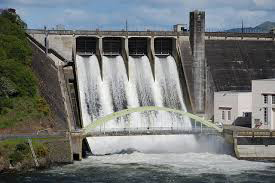Types of spillways
Depending on their utility, spillways are divided into two main types
- Main spillways or service spillways
- Emergency spillways
Main spillways or service spillways
They are masonry or concrete structure which functions for a designed flood in the rainy season. The main spillway can be constructed either within the body of a dam or at one end of it independently in a saddle in an away from the dam.
Based on hydraulic designs, spillways may be classified as follows
- Ogee spillways
- Side channel spillway
- Trough spillways or chute spillways
The shape of these types’ spillways is ogee or S-shaped. The overflowing water is guided smoothly over the crest. The downstream face of this overflow section of the dam conforms to the bottom surface of a freely failing jet of water to ensure smooth flow, free from separation. The ogee spillways are used in most of the gravity dams or they are having the more discharging capacity.
Emergency spillways
Emergency spillways are also called as breaching section and are provided in the earthen dam or rock-fill dam. It is constructed to dispose of the excess flood water more them the designed flood. Under normal reservoir conditions, the emergency spillway is not required to function. The top of the emergency spillway is kept below the top of the main dam but slightly above the H.F.L. when abnormal high flood water through it. However, it can be reconstructed afterwards. Thus it helps the main spillway in an emergency, otherwise, the water level will rise above the H.F.L. and overtop the dam causing its failure.

